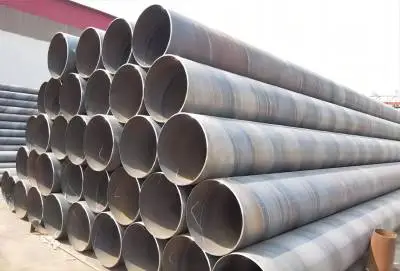Helical welded pipes, also known as spiral welded pipes, are cylindrical steel structures manufactured using a unique welding process. These pipes are widely used in various industries, including oil and gas, water transportation, and construction. This article will explore the characteristics, manufacturing process, and applications of helical welded pipe, providing insights into their importance in modern infrastructure.
|
|
|
Made of low carbon structural steel or low alloy steel strip:
Helical welded pipes are primarily manufactured using low carbon structural steel or low alloy steel strips. These materials are chosen for their excellent mechanical properties, including strength, ductility, and weldability. Low carbon steel typically contains less than 0.3% carbon, which makes it easier to weld and less prone to brittleness. Low alloy steels, on the other hand, contain small amounts of alloying elements such as manganese, nickel, or chromium, which enhance their strength and corrosion resistance.
The choice of steel grade depends on the intended application of the pipe. For instance, API 5L grade steel is commonly used for oil and gas pipelines, while ASTM A252 grade is preferred for piling applications. The steel strips used in helical welded pipe production are typically hot-rolled and may undergo additional heat treatment processes to achieve the desired mechanical properties.
Helical Welded pipes require special coiling before welding:
Before the actual welding process begins, the steel strips used to manufacture the products undergo a special coiling process. This step is crucial in preparing the material for the subsequent helical forming and welding stages. The steel strip is first uncoiled from large coils and then re-coiled at a specific angle, which determines the eventual diameter of the pipe.
The coiling process involves passing the steel strip through a series of rollers that gradually bend it into a spiral shape. The angle at which the strip is coiled is carefully calculated to ensure that when the edges are brought together for welding, they form a perfect cylinder with the desired diameter. This precise coiling is what gives the products their distinctive spiral seam pattern.
Internal and external welding:
A distinctive characteristic of helical welded pipe lies in their dual approach to welding process - an innovative technique that involves employing internal as well as external welding processes during their manufacture. This method begins with a coiled steel strip being shaped into a cylindrical form whereupon its edges are brought together and joined through welding operations conducted simultaneously from both the inside and outside surfaces of the pipe.
This simultaneous dual-welding process ensures excellent joint strength and uniformity along the entire length of the pipe, making the product exceptionally durable for various applications. It allows these pipes to maintain structural integrity under high-pressure conditions and harsh environments which are often encountered in sectors like oil & gas transportation, water conveyance systems, and large-scale construction projects.
The internal welding process provides a secure seal inside the pipe to prevent leaks and fluid loss while the external welding process ensures that the outer surface of the pipe is as robust as possible against external forces such as mechanical impacts or environmental factors. This dual-welding technique results in pipes with superior resistance to corrosion, fatigue, and wear & tear, enhancing their overall performance and lifespan compared to other types of welded pipes.
In essence, the use of both internal and external welding processes during the manufacturing of helical welded pipes is a testament to innovative engineering that delivers high-quality products suitable for a myriad of demanding applications across multiple industries.
The most common welding method used for the product is submerged arc welding (SAW). In this process, an electric arc is created between a continuously fed electrode wire and the pipe material. The arc and the weld pool are protected by a blanket of granular flux, which melts to form a protective slag over the weld. This method allows for high welding speeds and produces high-quality welds with excellent mechanical properties.
The internal and external welds are typically offset from each other, creating a zig-zag pattern when viewed from the end of the pipe. This arrangement helps to distribute stress more evenly along the weld seam, enhancing the overall strength and integrity of the pipe.
Why is Helical Welded pipe called JCOE pipe:
The term "JCOE pipe" is often used interchangeably with helical welded pipe, particularly in the oil and gas industry. JCOE stands for "J-ing, C-ing, O-ing, and Expanding," which describes the manufacturing process used to produce these pipes. However, it's important to note that JCOE typically refers to large-diameter longitudinally welded pipes, not helical welded pipes.
The confusion arises because both helical welded pipes and JCOE pipes are used in similar applications and are manufactured using advanced welding techniques. The main difference lies in the direction of the weld seam: helical welded pipes have a spiral seam, while JCOE pipes have a longitudinal seam.
Despite this distinction, the term JCOE is sometimes loosely applied to the product, especially when discussing large-diameter pipes used in pipeline projects. This usage, while not technically correct, has become somewhat common in industry parlance.
China Helical Welded pipe factory:
One such manufacturer is Longma, which offers helical welded pipes that comply with several product standards, including API 5L, ASTM A53, ASTM A500, ASTM A252, and ASTM A795. These standards ensure that the pipes meet specific requirements for chemical composition, mechanical properties, and dimensional tolerances.
When choosing a helical welded pipe manufacturer, it's important to consider factors such as production capacity, quality control processes, and compliance with relevant standards. Longma, for example, invites potential customers to contact them at info@longma-group.com for more information about their products and capabilities.
In conclusion, helical welded pipes are versatile and robust steel structures that play a crucial role in various industries. Their unique manufacturing process, which involves special coiling and dual-sided welding, results in pipes that are both strong and cost-effective. While sometimes confused with JCOE pipes, helical welded pipes have their own distinct characteristics and advantages. As the demand for these pipes continues to grow, manufacturers like those in China are at the forefront of production, offering high-quality products that meet international standards.














